

Introduction to accessing the Raspberry Pi's GPIO in C++ (sysfs) · Hertaville.com. Introduction In this blog entry I will demonstrate how one can access the Raspberry Pi's GPIO in C++.
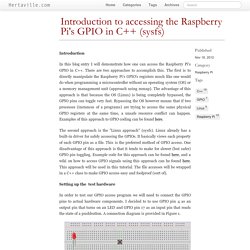
There are two approaches to accomplish this. The first is to directly manipulate the Raspberry Pi's GPIO's registers much like one would do when programming a microcontroller without an operating system (OS) or a memory management unit (approach using mmap). The advantage of this approach is that because the OS (Linux) is being completely bypassed, the GPIO pins can toggle very fast. Bypassing the OS however means that if two processes (instances of a programs) are trying to access the same physical GPIO registers at the same time, a unsafe resource conflict can happen. The second approach is the "Linux approach" (sysfs). Introduction to accessing the Raspberry Pi's GPIO in C++ (sysfs) · Hertaville.com.
Raspberry Pi Tutorial Series: Serial - Waveshare Wiki. Raspberry Pi: C++ cross-compiling in Eclipse – Software Engineering Notes. Based on this GuruCoding page.

Environment Ubuntu 16.04 LTSEclipse Neon.3 Release 4.6.3arm-linux-gnueabihf (Ubuntu/Linaro 5.4.0-6ubuntu1~16.04.4) 5.4.0 20160609Raspberry Pi 3 Model B. Development Environment for the Raspberry Pi using a Cross Compiling Toolchain and Eclipse · Hertaville.com. UPDATED September 7th 2014.
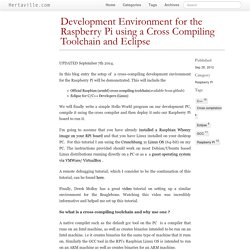
In this blog entry the setup of a cross-compiling development environment for the Raspberry Pi will be demonstrated. This will include the We will finally write a simple Hello World program on our development PC, compile it using the cross compiler and then deploy it onto our Raspberry Pi board to run it. I'm going to assume that you have already installed a Raspbian Wheezy image on your RPi board and that you have Linux installed on your desktop PC. For this tutorial I am using the Crunchbang 11 Linux OS (64-bit) on my PC.
A remote debugging tutorial; which I consider to be the continuation of this tutorial, can be found here. Finally, Derek Molloy has a great video tutorial on setting up a similar environment for the Beaglebone. Remote Debugging of Raspberry Pi Applications From Eclipse · Hertaville.com. In this entry I will outline how one can utilize remote debugging tools available in Eclipse to debug applications from a Linux Desktop PC while running (in debug mode) on the Raspberry Pi.

This tutorial assumes that you have already setup your Raspberry Pi cross compiling toolchain and Eclipse and that you are able to build your applications in Eclipse (using the cross-compiling toolchain) as well as transfer the binary executables to the Raspberry Pi via the RSE plugin. If you have not done so, I urge you to look at the "Development Environment for the Raspberry Pi using a Cross Compiling Toolchain and Eclipse" since this tutorial is really a continuation of the tutorial in that blog entry.
To make things easy, I will use the same project created in that previous entry and modify the code slightly to the following: This gives us a slightly longer program that makes demoing the debug process easier. Before moving onto the debugging, make sure you clean the project and rebuild it. Google Home + Raspberry Pi Power Strip: 6 Steps. Starter application now available!
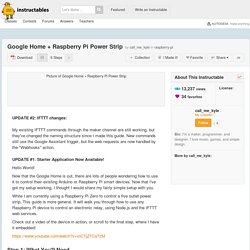
Vist to download a starter application for this project, and follow the README to get it configured and running on your own device. You can also check out my more-fleshed-out React project at if you are interested in seeing a slightly more complex version of the project The main step is to build an Node + Express server that is able to handle POST requests. In my code, it looks like this: app.post('/api/switches/:id', function(req, res){ var foundSwitch = getSwitch(req.params.id); foundSwitch.toggle(); saveState(); console.log("postSwitch "+JSON.stringify(foundSwitch)); res.json(foundSwitch); }) I make a post request to /api/switches/:id, where id is written as sw1, sw2, and so on. I wrote individual python scripts for off and on functions, specifying which GPIO pin was tied to each switch. for example, sw1_on.py looks like: import RPi.GPIO as GPIO<br>GPIO.setwarnings(False) GPIO.setmode(GPIO.BCM) GPIO.setup(23, GPIO.OUT)
Linux & Python Packages for My Raspberry Pi « Jeff's Skinner Box. I have two Raspberry Pi’s (RPi) and will likely have more as proceed deeper into the projects I have identified.
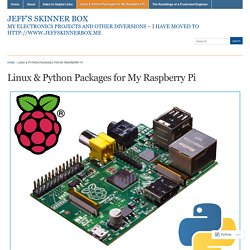
Not all the RPi’s will be configured the same and I’m using this page to document what Linux and Python packages I have loaded. My Raspberry Patch Do Your House Cleaning First I’m loading software via the Linux apt-get utility and you need to make sure its database is up to date. First thing to do is to update apt-get’s local database with server’s pkglist’s files.
Then checks for outdated packages in the system and automatically upgrades them. Scroll pHAT HD at Raspberry Pi GPIO Pinout. Step01 – Bare Metal Programming in C Pt1 – Valvers. Although the Raspberry-Pi comes with a good Linux distribution, the Pi is about software development, and sometimes we want a real-time system without an operating system.

I decided it’d be great to do a tutorial outside of Linux to get to the resources of this great piece of hardware in a similar vein to the [Cambridge University Tutorials]( which are excellently written. However, they don’t create an OS as purported and they start from assembler rather than C. I will simply mimic their tutorial here, but using C instead of assembler. .Installing NetBeans For C++ Remote Development on A Raspberry Pi – Raspberry Pi Projects. THIS IS NOW OUR PREFERRED WINDOWS DEVELOPMENT IDE FOR THE RASPBERRY PI The reason – you program on your nice fast Windows PC but under the bonnet it copies the files and uses the RPi to actually compile the project which, whilst a bit slower than using a high spec PC, solves all the issues of platform architecture, installed libraries, etc.
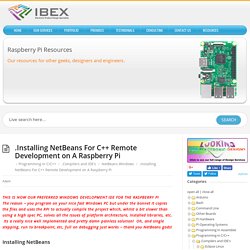
Its a really nice well implemented and pretty damn painless solution! Oh, and single stepping, run to breakpoint, etc, full on debugging just works – thank you NetBeans gods! Installing NetBeans Download NetBeans IDE from Select the download which includes the C/C++ option. Run NetBeans NetBeans New Install Configuration The following are options we like to use to make netbeans behave like other IDE's we use and to correct things we find annoying. .Setting Up Windows Eclipse Programming of the RPi – Raspberry Pi Projects. We no longer use this approach and this page may be out of date – it is left here for archive puropses.
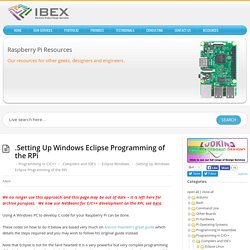
We now use NetBeans for C/C++ development on the RPi, see here. Using A Windows PC to develop C code for your Raspberry Pi can be done. These notes on how to do it below are based very much on Alessio Placitelli's great guide which details the steps required and you may wish to follow his original guide instead. Note that Eclipse is not for the faint hearted! It is a very powerful but very complex programming IDE which can easily confuse the hell out of you and have you banging your head against a wall for hours if it doesn't just work, often because something has changed requiring some new set-up step to make things work as before or work the same on your system compared to the system of someone who has created a set-up guide (just like this one!). Distro Picker. To celebrate the cover feature on the latest Linux Format, we've built a web app that helps you find out which Linux distro is right for you.
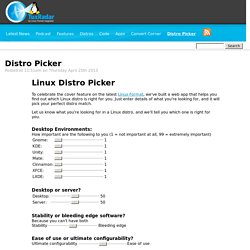
Just enter details of what you're looking for, and it will pick your perfect distro match. Let us know what you're looking for in a Linux distro, and we'll tell you which one is right for you. Desktop Environments: 40+ Cool Ideas for your Raspberry PI Project. Raspberry Pi Projects, How-Tos and More for Makers.
Raspberry gPIo. .Getting Your RPi Ready For C Programming – Raspberry Pi Projects. C is a natural choice to program in on the Raspberry Pi. It's very powerful, usable on virtually all hardware platforms and really similar to lots of other programming languages such as Java, PHP, C# and objective C. As popular programming languages go its as powerful as it gets, with only assembler beating it in terms of programming to the bare metal of a hardware platform. Its also what Linux itself is written in. The notes on this site are largely focused on programming in C and C++ and we typically do this running on the Raspbian operating system. If you are a beginner don't worry about the distinction between C and C++ too much. .Installing NetBeans For C++ Remote Development on A Raspberry Pi – Raspberry Pi Projects. Low Level Programming of the Raspberry Pi in C. One of the things that disappointed me when I first got my Raspberry Pi was the fact that everybody was doing very high level programming with it.
I wanted to program it like I used to do with microcontrollers, but it seemed like this was not as easy as I thought it would be. I believe however, that for embedded applications, you should be very cautious about dependencies, thus try to use as few libraries as possible. Silverlight Developer » Blog Archive Bare Metal GPIO on the Raspberry Pi - Silverlight Developer. The Raspberry Pi is classically used as a single board computer running Linux but it also offers the possibility of using the board without Linux (known as bare metal development).
Add to this the availability of free ARM development tools and we have the opportunity to develop on a high speed ARM processor at a reasonable cost. This post explores the steps necessary to toggle a GPIO pin on the Raspberry Pi by directly accessing the registers without the presence of an operating system. Raspberry Pi - run program at start-up. Anyway, I wanted to get my Raspberry Pi to start no-ip dynamic dns service when it started-up, so I wouldn't have to remember to start it every time it was powered up. For details on how to install no-ip on the Pi, see this post. There are loads of ways of running a command at start-up in Linux but my favoured approach is to create an initialisation script in /etc/init.d and register it using update-rc.d. This way the application is started and stopped automatically when the system boots / shutdowns.
Create script in /etc/init.d sudo nano /etc/init.d/NameOfYourScript The following is an example based on starting up the no-ip service [/usr/local/bin/noip], but change the name of the script and the command to start and stop it and it would work for any command. Dwelch67/raspberrypi. Bare-metal Raspberry Pi Programming. This book aims to be a guide and reference to low-level programming on the Raspberry Pi. If you are interested in porting an existing operating system, writing a new operating system, or just curious about the gory details of the Raspberry Pi then you've found the right place. The idea is to bring all the bits and pieces that are out there now together into a single place.
Topics to be covered include Hardware detailsThe bootup sequenceARM assembly languageObtaining a toolchainPeripheral interfaces (graphics, network, usb, gpio, etc.)Memory mappingLow-level debuggingRaspberry Pi Hub Wiki Examples[edit] View forum - Bare metal. FAQ Register Login Bare metal. RPi Low-level peripherals. Back to the Hub Hardware & Peripherals: Raspberry Pi. The Raspberry Pi is a series of credit card-sized single-board computers developed in the United Kingdom by the Raspberry Pi Foundation with the intent to promote the teaching of basic computer science in schools and developing countries.[8][9][10] The original Raspberry Pi and Raspberry Pi 2 are manufactured in several board configurations through licensed manufacturing agreements with Newark element14 (Premier Farnell), RS Components and Egoman.[11] The hardware is the same across all manufacturers.
Raspberry Pi 3 Model B GPIO 40 Pin Block Pinout. RPi GPIO Code Samples. The Raspberry Pi GPIOs can be controlled using many programming languages. Examples in different C-Languages. Direct register access Gert van Loo & Dom, have provided some tested code which accesses the GPIO pins through direct GPIO register manipulation in C-code. Computer Laboratory – Raspberry Pi: Baking Pi – Operating Systems Development. This course has not yet been updated to work with the Raspberry Pi models B+ and A+. Some elements may not work, in particular the first few lessons about the LED. Computer Laboratory: Computer Lab Raspberry Pi Tutorials. Welcome to the tutorials page.
This is where we showcase projects and tutorials created by students during the summer vacation. Step01 – Bare Metal Programming in C Pt1 – Valvers. Bcm2835: C library for Broadcom BCM 2835 as used in Raspberry Pi. Download & Install. WiringPi is now maintained under GIT for ease of change tracking, however there is a Plan B if you’re unable to use GIT for whatever reasons (usually your firewall will be blocking you, so do check that first!) If you do not have GIT installed, then under any of the Debian releases (e.g.
BCM2835 ARM Peripherals. Raspberry gPIo. Raspberry Pi FAQs - Frequently Asked Questions. Table of Contents: The Raspberry Pi is a credit-card-sized computer that plugs into your TV and a keyboard. It is a capable little computer which can be used in electronics projects, and for many of the things that your desktop PC does, like spreadsheets, word processing, browsing the internet, and playing games. It also plays high-definition video. We want to see it being used by adults and children all over the world to learn programming and digital making. You can read more about the Raspberry Pi here. The Raspberry Pi Foundation is a charity, so you can’t buy shares in the company. Raspberry Pi Foundation - About Us.
Programming the ARM chip. Raspberry Pi: Downloads. Raspberry gPIo. Build your own Google TV Using RaspberryPi, NodeJS and Socket.io.